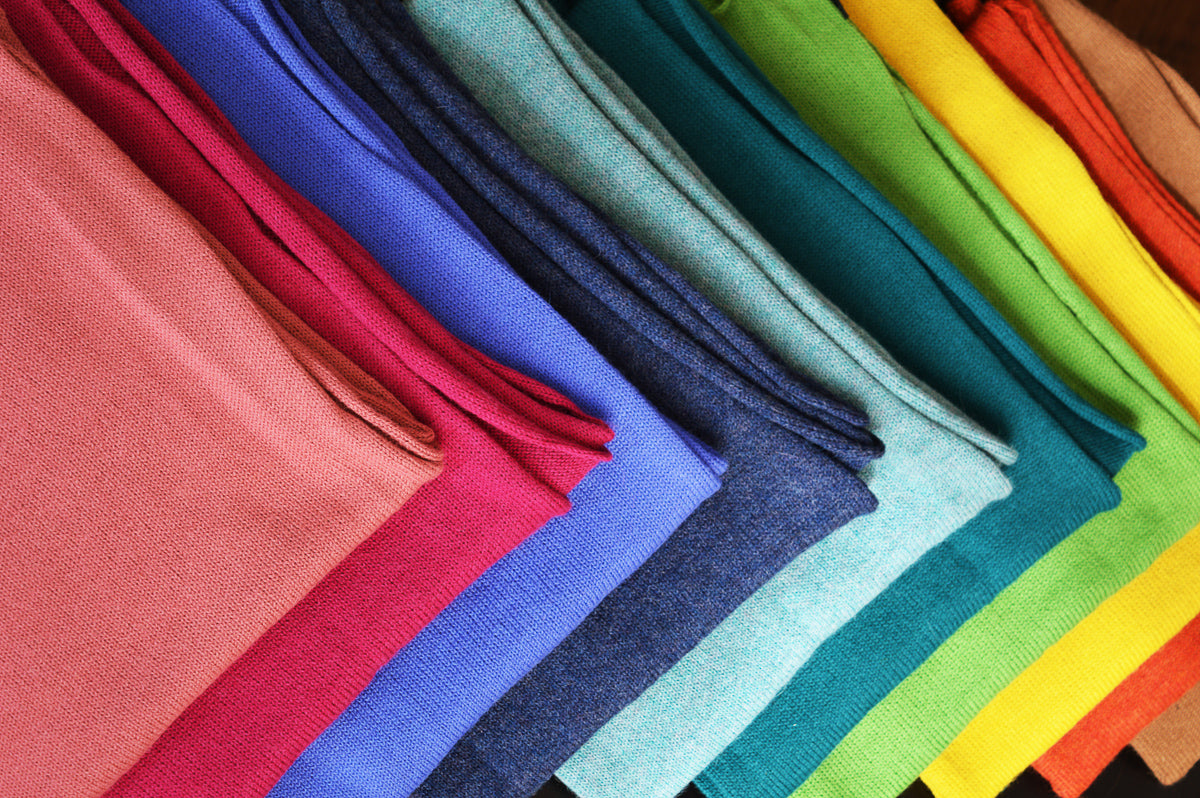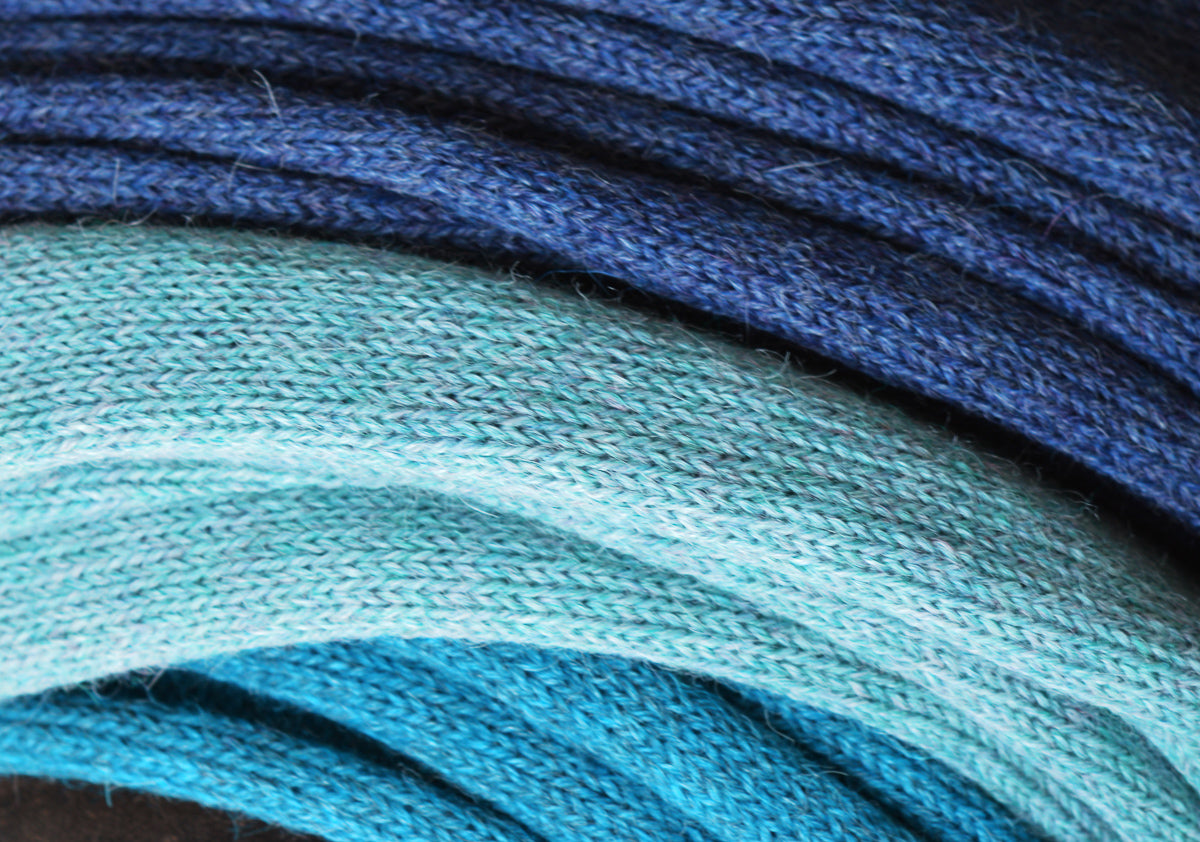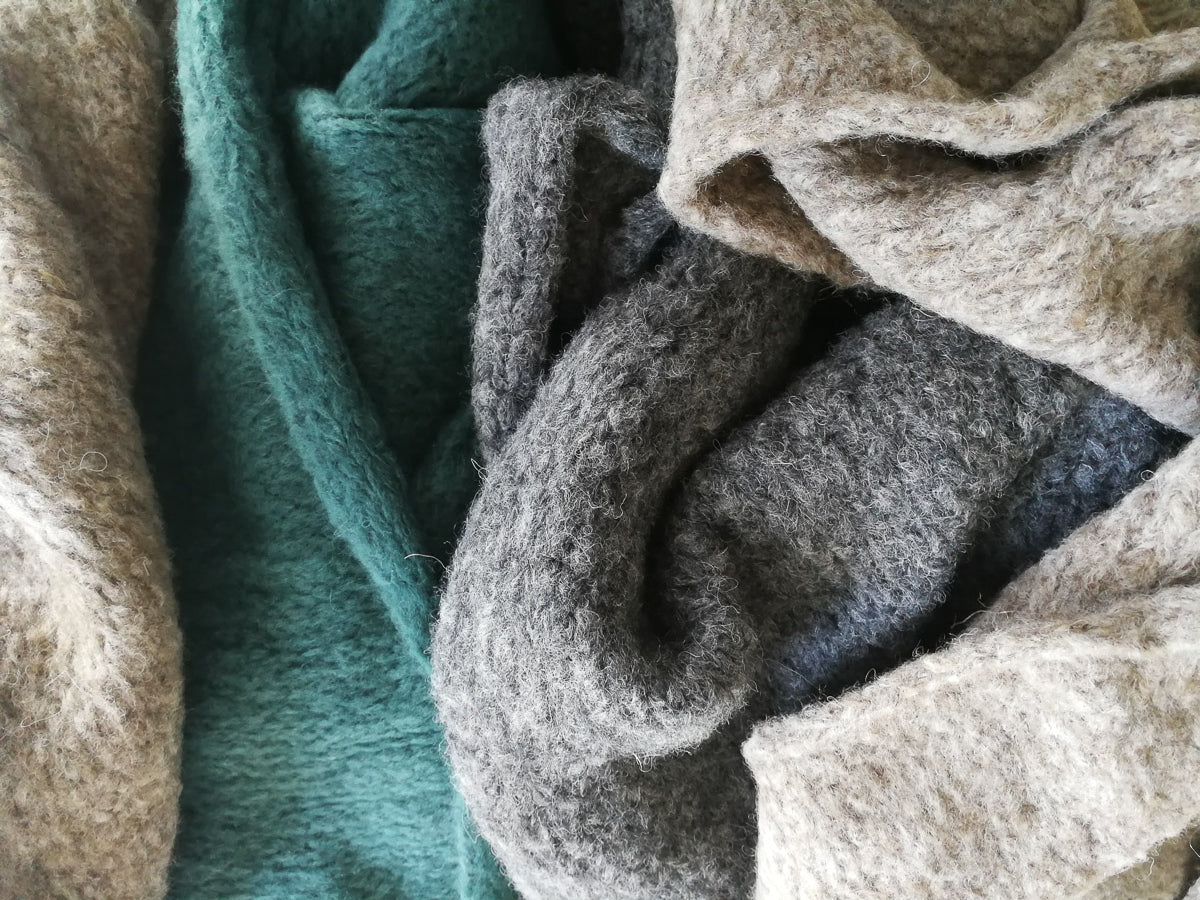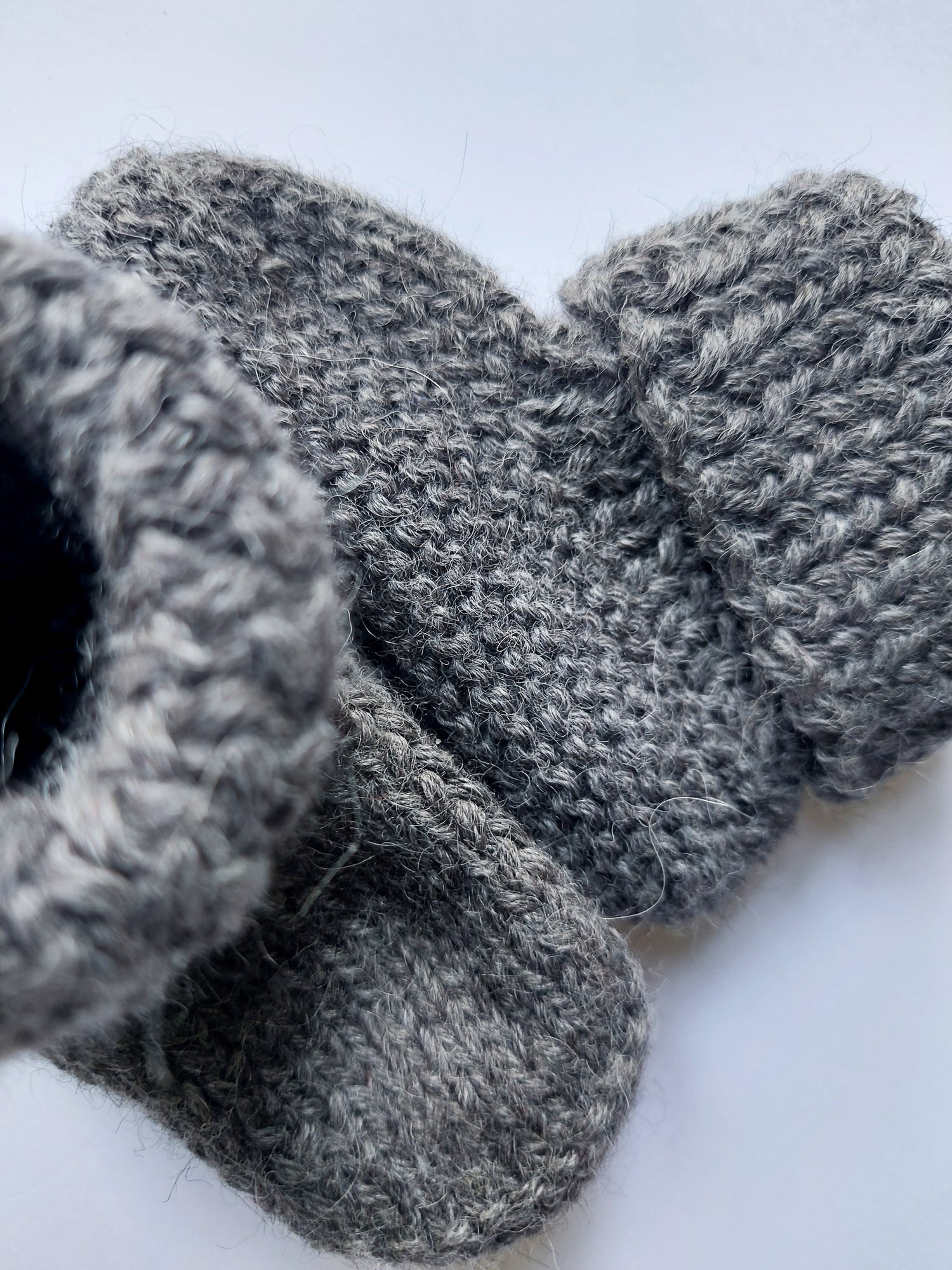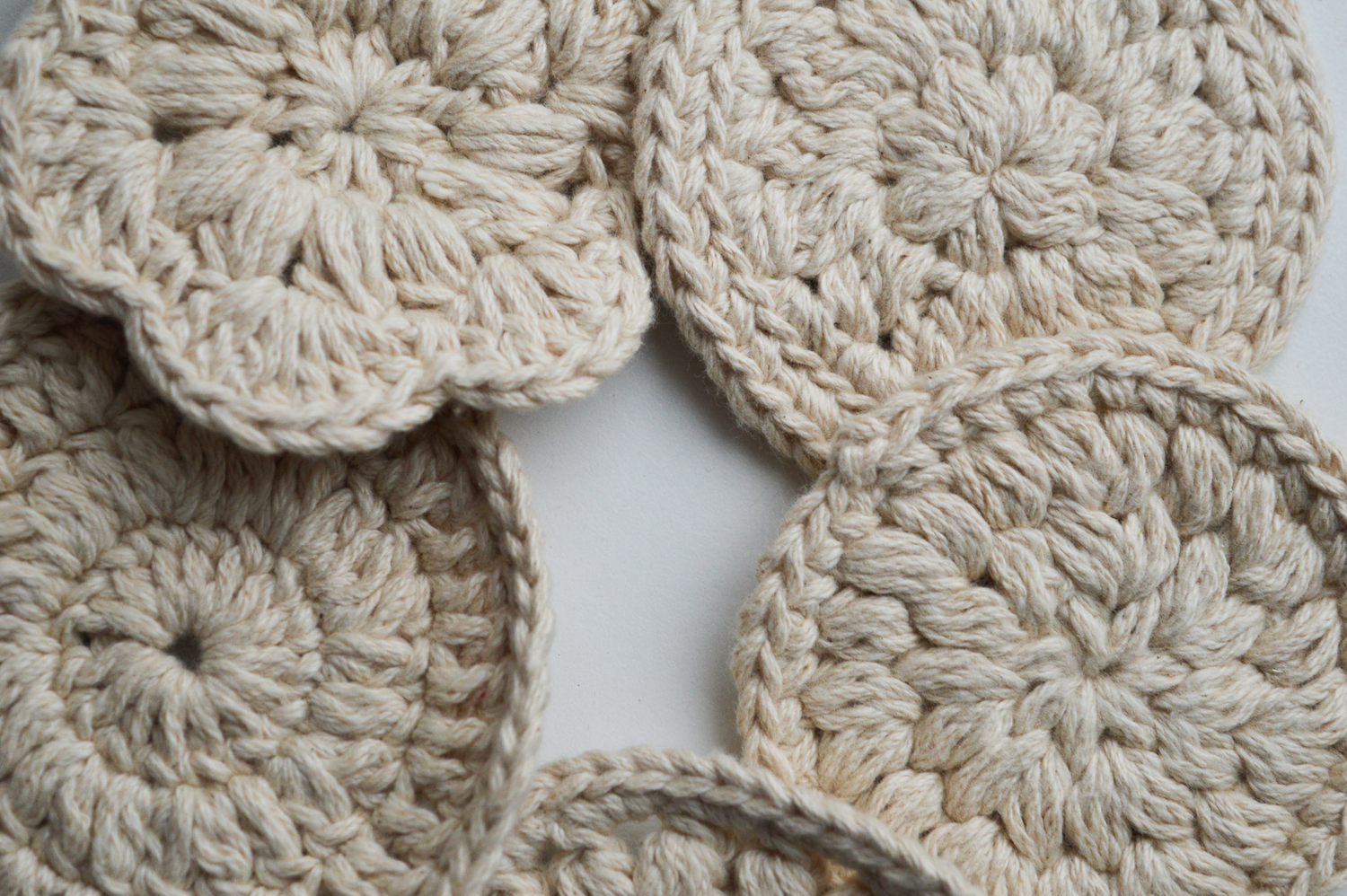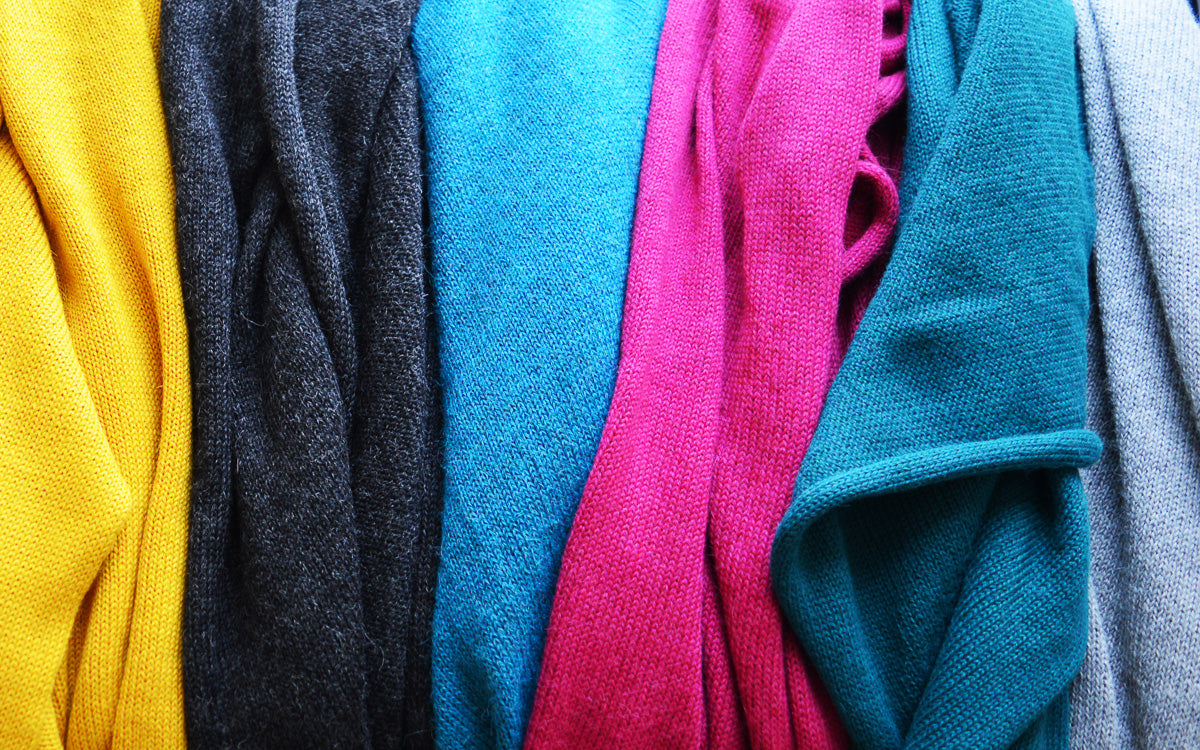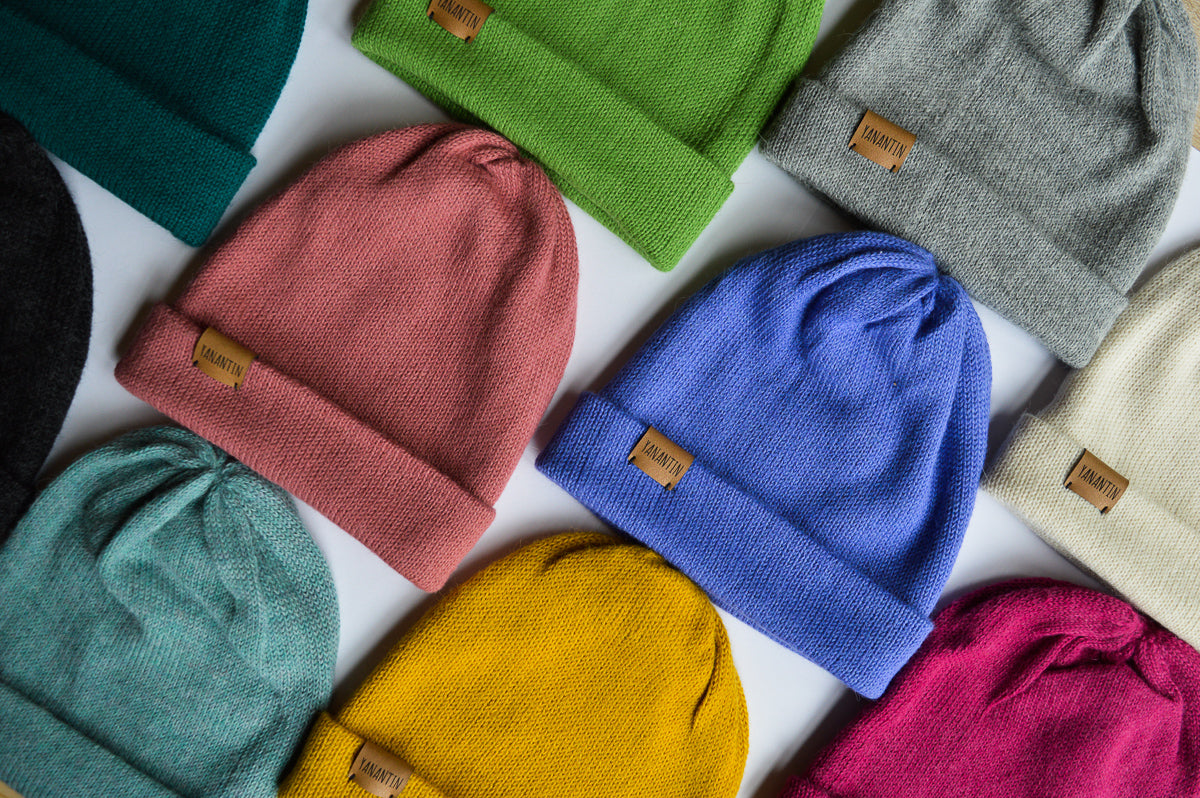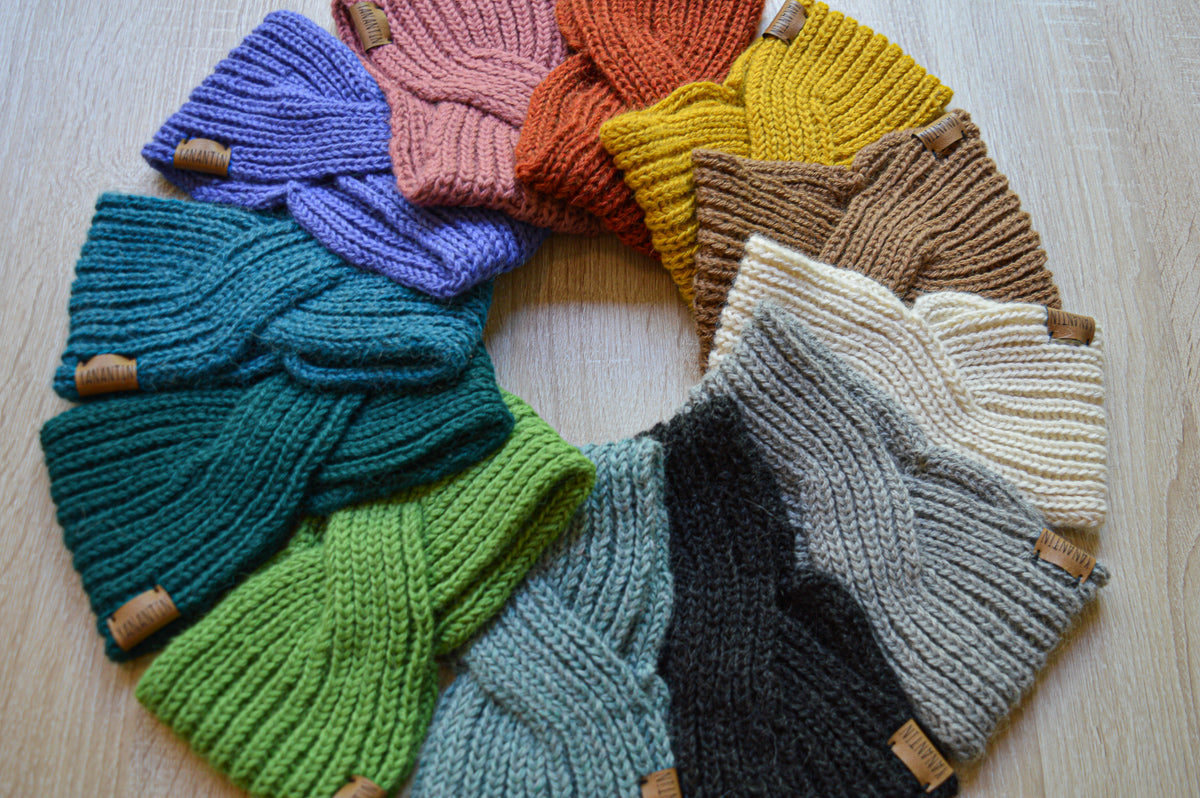When I lived in Peru, people would often ask the same question: What’s the difference between alpaca and llama wool? Now, after working hands-on with these fibers through my own brand, I’ve come to see just how nuanced that question really is.
Llama and alpaca wool differ in softness, warmth, and fiber fineness. Alpaca wool, especially "baby" and "royal" alpaca, is finer (18–26 microns), softer, and better for sensitive skin. Llama wool is coarser (25–32 microns), more insulating, and more durable.
|
Aspect |
Alpaca Wool |
Llama Wool |
|
Softness & Fiber Diameter |
Softer, silkier; 23–26 microns (baby & royal alpaca are finer) |
Coarser, itchier; 25–32 microns, exceptions up to 20 microns |
|
Warmth & Texture |
Warm and comfortable, less prickly |
Slightly warmer but more prickly |
|
Processing & Availability |
Easier to process; widely available internationally |
More labor-intensive; mostly local/artisanal |
|
Common Producing Countries |
Peru (main), Bolivia |
Bolivia (main), Argentina |
|
Best Uses |
Scarves, sweaters, baby clothing, soft hats |
Outerwear, rugs, blankets, heavy-duty coats |
|
Key Price Points |
Knitted hats: $40 – $60 Woven ponchos: $75 – $120 |
Knitted hats: $20 – $40 Woven ponchos: $75 – $100 |
While these cousin camelids may look alike, their fibers differ in comfort, cost, and environmental impact in ways that matter whether you’re shopping for a winter scarf or building a sustainable wardrobe.
Alpaca vs. Llama Wool: Key Differences
Llama and alpaca wool both come from South American camelids and are often seen as similar, but there are important differences in texture, comfort, processing, and use.
1. Softness and Fiber Diameter
The main difference lies in fiber fineness. Alpaca wool is softer, silkier, and more comfortable on the skin, especially baby alpaca (20–23 microns) and royal alpaca (<18 microns).
Llama wool typically ranges from 25 to 32 microns, making it coarser and often itchier, especially for sensitive skin.
This makes alpaca ideal for scarves, sweaters, and next-to-skin garments, while llama wool is better suited for outerwear or decorative textiles.
2. Warmth and Texture
Because llama fiber is thicker and denser, it provides slightly more warmth than alpaca. However, this comes at the cost of comfort: llama wool is more likely to feel prickly, while alpaca stays warm without irritation.
3. Processing and Availability
Alpaca fleece is relatively uniform, making it easier to clean and spin. Llama fleece contains guard hairs that must be manually separated, adding time and cost to production.
As a result, alpaca wool is more common in international markets, while llama wool is more often found in local or artisanal settings, especially in Bolivia and Argentina.
4. Sustainability and Use
Both fibers are natural, biodegradable, and sustainably sourced, requiring minimal water and no harmful chemicals for processing. However, scaling up alpaca production (especially industrialized) could change that.
That said, alpacas have been selectively bred for fiber quality, especially in Peru, while llamas were traditionally bred as pack animals, which limited the focus on wool fineness.
Because alpacas have been bred specifically for their fleece, it’s easier to produce their wool on a commercial scale. On the other hand, llama wool tends to be more niche and artisanal, with less consistency in quality… Something to keep in mind if you’re thinking about supply chains or making products.
Best Uses for Alpaca vs Llama Wool
|
Alpaca Wool Uses: |
Llama Wool Uses: |
|
|
Softness and Fiber Diameter Differences Between Alpaca and Llama Wool
One of the primary factors influencing the softness of wool is the fiber diameter, measured in microns. Alpaca wool is generally finer than llama wool, which means it is softer and more comfortable against the skin.
-
Alpaca Wool: Typically ranges from about 18 to 26 microns, with “baby alpaca” often between 21 and 23 microns. The finer the fiber, the softer and less itchy the wool feels. This is why alpaca is often favored for garments worn close to the skin, especially by those with sensitive skin.
-
Llama Wool: Usually has a broader and coarser diameter, generally ranging from 26 to 31 microns. This coarser texture makes llama wool more scratchy or prickly compared to alpaca. However, some rare high-quality llama fibers can be softer, particularly those that come from specific breeds or are carefully combed.
-
However, there are exceptions of llama wool being incredibly soft, too! Especially when garments include the soft undercoat.
|
Alpaca Category |
Alpaca Micron Range (µm) |
Llama Micron Range (µm) |
Llama Category |
|
Royal |
< 18 |
18 – 22 |
Woolly |
|
Super Fine |
18 – 20.5 |
25.5 |
Fine Classic |
|
Baby |
20.6 – 22.5 |
28 |
Standard Classic |
|
Fine |
22.6 – 25.5 |
— |
— |
|
Medium |
25.6 – 30 |
— |
— |
|
Strong |
> 30 |
32 |
Coarse |
Sources: https://www.alpacainfo.com/academy/article/4662/u.s.-alpaca-fiber-standard and https://lostcreekllamas.com/fiber.htm
Because of this difference in fiber diameter, alpaca wool has a smoother, more luxurious feel, while llama wool is often thicker and warmer but can be less comfortable if worn directly on (sensitive) skin.
In general, the following ranges can be applied to determine whether a fiber is itchy or not:
-
Note, however, that fiber softness and itchiness are influenced primarily by micron diameter, but individual sensitivity varies. Processing methods, fiber structure, and blend compositions also affect comfort. Therefore, these guidelines serve as general indicators, not absolute rules.
|
Itch-free |
Scratchy for sensitive skin |
Itchy for everyone |
|
<20 microns |
21 – 29 |
>30 |
Warmth and Texture: Why Llama is Warmer and Alpaca Softer
Llama fibers are generally coarser and thicker than alpaca fibers which is why llama wool tends to be a bit warmer. But that thicker, rougher texture means llama wool can feel prickly or scratchy against the skin.
Alpaca fibers, on the other hand, are finer and smoother, with a more consistent thickness. A special feature of the alpaca fiber is its hollow core, which traps heat that keeps you warm. It makes alpaca wool quite unique in its ability to provide warmth without weight or bulk.
Llama wool is generally warmer because its fibers are thicker and denser. However, alpaca wool provides great warmth while being lighter in weight, making it ideal for lightweight yet insulating clothing.
Summarizing the alpaca fiber:
-
Hollow cores that trap air, providing excellent insulation.
-
Fine, smooth, and generally very soft to the touch.
-
Warmth is lightweight yet effective due to trapped air inside fibers.
-
Comfortable to wear, less likely to irritate sensitive skin.
Summarizing the llama fiber:
-
Thicker, denser fibers without hollow cores.
-
Coarser and rougher texture, more prone to prickliness.
-
Warmth comes from the bulk and density of the fibers, offering substantial insulation.
-
Can be scratchy and less comfortable for sensitive skin.
Processing and Availability
Alpaca is typically the easier fiber to find because it is pretty straightforward to work with. The uniform fibers make cleaning and spinning easier and faster. Llama wool has more guard hairs that need to be sorted out by hand—obviously adding time and effort.
Therefore, alpaca wool is more widely available internationally, while llama often requires seeking out specialty shops or local producers who value its unique qualities despite the extra work involved in processing.
Processing Alpaca Fleece
Alpaca fleece tends to be relatively uniform and fine, making it easier to clean, sort, and spin compared to llama wool. This uniformity helps streamline the processing, reducing labor and cost, which contributes to alpaca wool’s wider availability on international markets.
The demand for alpaca fiber has grown globally, especially for use in high-quality textiles and fashion, supporting a more developed supply chain.
Alpaca wool primarily comes from:
-
Peru: The largest producer and exporter of alpaca wool worldwide.
-
Bolivia: Another important source with a growing alpaca industry.
-
Chile: Smaller but notable alpaca production exists here, mainly in artisan communities.
-
Argentina: Has alpaca farming, though on a smaller scale compared to Peru and Bolivia.
Processing Llama Fleece
Llama fleece is more variable in texture because it contains a higher proportion of coarse guard hairs alongside the softer undercoat fibers. These guard hairs must be carefully separated during processing, which is a labor-intensive and time-consuming step.
Did you know that the separating of guard hairs and undercoat is done manually? No wonder it’s labor intensive!
This extra processing increases production costs and limits llama wool’s availability mostly to local and artisanal markets, especially in regions like Bolivia and Argentina.
Because of these factors, llama wool remains less common in global markets and is often considered a hidden gem in the textile world, prized primarily in regional markets but less widely available internationally compared to alpaca wool.
Llama wool mostly comes from the same regions where the animals are raised:
-
Bolivia: The biggest source of llama wool, especially from small-scale and artisanal producers in the Altiplano.
-
Peru: Produces llama wool but on a smaller scale compared to alpaca.
-
Argentina: Has niche llama wool markets, often tied to local crafts and traditional uses.
-
Chile: Contributes modestly, with artisan communities working with llama fiber.
In short, Peru dominates alpaca production globally, while Bolivia is a hotspot for llama wool, especially in small-scale and artisanal contexts.
Comparing the Price of Alpaca and Llama Wool
When it comes to price, alpaca and llama wool tend to fall into somewhat similar ranges, but there are key differences worth noting.
-
Raw fiber and yarn prices for both alpaca and llama are generally close. Baby alpaca fiber commands a premium, often costing more than regular alpaca or llama fibers.
-
Finished products like garments usually reflect this: alpaca items, especially those made from baby alpaca, tend to be pricier due to their softness and wider market demand.
-
Llama raw fiber tends to be cheaper, but because its fleece requires more labor-intensive sorting and processing, the final garments can be similarly priced or sometimes more expensive than alpaca products.
-
Alpaca wool benefits from a larger international market and more established supply chains, helping stabilize its price and availability worldwide.
-
Llama wool is more niche and often found in local or artisanal markets, especially in Bolivia and Argentina, which can limit large-scale pricing competition but also create unique, sometimes higher-priced pieces.
-
The perceived luxury status of alpaca may drive prices more than actual cost differences.
So, while alpaca products often do carry a premium due to consistent softness and wider market demand, llama wool garments (especially artisanal or locally made ones) can sometimes be similarly priced or even more expensive due to their niche, handcrafted nature.
Price Comparison Chart
Given that llama wool's raw fiber is generally cheaper but requires more labor-intensive processing, the final garment price doesn't always reflect that initial cost advantage.
|
Product |
Alpaca Price Range |
Llama Price Range |
|
Raw Fiber (per ounce) |
$8 - $10 |
$3 - $6 |
|
Yarn (50g / 1.76 oz.) |
$8 - $12 |
$5 - $10 |
|
Knitted Hat |
$40 - $60 |
$20 - $40 |
|
Woven Poncho |
$75 - $120 |
$75 - $100 |
This chart comes from a mix of sources, including:
-
Online marketplaces and specialty fiber retailers selling alpaca and llama products
-
Reports from industry groups and NGOs focused on Andean textile crafts
-
My own experience in South America :)
Keep in mind that exact prices fluctuate due to quality, fiber grade, processing methods, and local vs. export markets. So, these ranges reflect typical prices but aren’t fixed or universal.
Sustainability and Use: Alpaca Compared to Llama Wool
When it comes to sustainability, both alpaca and llama wool have strong environmental credentials, but there are some differences worth noting.
Environmental Impact
Both animals are well-adapted to the harsh Andean environment and have a relatively low ecological footprint. They consume less water and food compared to many other livestock, and their fleece doesn’t contain (much) lanolin, which reduces the need for heavy chemical processing.
-
I wrote an entire article about the environmental impact of alpacas. Read it here: Is Alpaca Wool Sustainable?
Animal Welfare
Since alpaca fleece is more uniform and alpacas themselves are more uniform as well, they are easier to shear. This can make their care simpler and potentially less stressful for the animals. Meaning it requires less effort and manpower to shear alpacas.
Llamas, on the other hand, require more careful shearing and maintenance to avoid health issues like hypothermia or sunburn, especially because their fiber can felt more easily.
-
What does that process actually look like? Read it in one of my articles: How Is Alpaca Wool Made and Is It Ethical?
The frequency of shearing and proper care depend on the specific climate, individual llama, and management practices, but in general, there’s quite a bit of things to consider when it comes to llama care.
-
Llamas are typically shorn every 1 to 2 years, though in hotter climates, annual shearing is more common to prevent overheating.
-
Regular brushing helps prevent fleece from matting and felting, especially for llamas with longer or denser fiber.
-
Shearing too frequently can increase the risk of hypothermia, although this is uncommon if animals are properly managed and protected from cold conditions. :)
-
If the fleece is too short or absent, llamas (especially those living at high altitudes or in sunny environments!) can be susceptible to sunburn.
-
Conversely, if llamas are not shorn, they risk overheating during warmer months.
-
Different types of llama fleece (varied in texture and density) require different handling methods such as shearing, clipping, or combing.
-
Individual llamas show wide variation in fleece thickness, length, and quality, so shearing and care practices should be tailored accordingly.
For more detailed information, I would recommend reading more on Lost Creek Llamas.
Durability and Use
Alpaca fiber is finer and less prone to felting, which helps garments maintain their softness, shape, and overall integrity over time. This makes alpaca ideal for wearable, long-lasting clothing that stays comfortable and attractive with use.
In contrast, llama fiber is coarser and thicker, offering greater abrasion resistance and toughness. This durability makes llama wool well-suited for rugged applications like outerwear, rugs, or home textiles.
In short,
-
Llama fiber’s coarseness lends strength and wear-resistance, especially useful for heavy-use items.
-
However, llama wool felts more easily, which can cause matting and weaken fabric structure if not cared for properly.
-
Alpaca wool resists felting better, helping garments avoid pilling and matting, thus preserving comfort and appearance longer.
Ultimately, durability depends on the use case: llama wool excels in rugged durability, while alpaca offers lasting softness and resilience, making each fiber valuable in different contexts.
Sourcing and Scale
Alpaca wool is more widely available on the international market, thanks to larger-scale production in Peru and Bolivia. Llama wool, often harvested in smaller quantities with more labor-intensive processes, remains more common in local and artisanal markets, particularly in Bolivia and Argentina.
In essence, if sustainability and animal welfare are top priorities, both fibers offer eco-friendly options, but alpaca’s easier processing and broader availability often give it an edge in mainstream sustainable fashion.
Did you know that llama wool often supports smaller-scale, artisanal economies? If you’re a conscious consumer you will LOVE this. I remember some beautiful local shops that are often locally managed or supported by international NGOs where I found beautiful llama wool products during my time living in Bolivia.
Sustainability: Alpaca vs. Llama Wool
Alpacas and llamas are close relatives living in similar environments, producing fibers that share many sustainable qualities. Both animals have clean fleeces without lanolin, which means less water and fewer chemicals are needed in processing: an eco-friendly advantage over many other natural fibers.
Certified and Responsible Sourcing
Both alpaca and llama wool come mostly from small-scale, local producers who prioritize responsible animal care. However, neither fiber currently benefits from widespread formal certification programs, so buying responsibly often depends on knowing the source.
Look for producers emphasizing animal welfare and small-scale, sustainable methods.
Chemical Use and Waste
Both fibers require limited chemical input during processing since they don’t have lanolin. However, the possibility of industrial scouring chemicals and dyes exists for both, depending on production practices. Thankfully, these fibers tend to produce very little waste.
Natural color alpaca and llama fibers need less processing and chemicals.
Water Usage
Water use during the animals' lives is minimal since alpacas and llamas are adapted to arid environments. Their fiber washing also uses less water compared to wool that contains lanolin.
Animal Welfare
Both animals are generally raised with care, but llamas need particular attention. For example, improper shearing timing can lead to health risks like hypothermia or sunburn. Ethical treatment is crucial for sustainability in both cases.
Proper animal care supports fiber quality and ethical standards.
Durability and Felting
Alpaca fiber is finer and less prone to felting, helping garments maintain softness, shape, and integrity over time. Llama fiber, while tougher and coarser, felts more easily—which can be a plus for felted crafts but may reduce garment longevity if not maintained carefully.
Likeliness of felting varies: alpaca fibers resist felting to maintain softness, while llama fibers felt more easily, making them better suited for rugged uses and felted crafts.
Comfort and Skin Sensitivity
Both fibers are lanolin-free and relatively skin-friendly. Baby alpaca is known for being itch-free, while regular alpaca and llama wool can sometimes be scratchy, depending on fiber quality.
Reusability and Biodegradability
Both alpaca and llama fibers are biodegradable when undyed, and both can be reused or recycled into new textile products, supporting circular fashion initiatives.
Comparing the Features of Alpaca Wool and Llama Fiber
Alpaca and llama wool share many qualities, but a few key differences set them apart. Both fibers are breathable, water-repellent, and lightweight, making them great for comfortable clothing. However, some features vary depending on fiber grade and type.
|
Feature |
Alpaca |
Llama |
|
Water-repellent |
Yes, naturally water-resistant |
Yes, similarly water-resistant but varies |
|
Water absorption |
Around 30%, retains warmth when damp |
Similar moisture absorption |
|
Wind-resistant |
Yes |
Yes |
|
Warmth |
Very warm, especially fine grades |
Slightly warmer on average due to coarser fibers, but difference is modest |
|
Breathable |
Yes |
Yes |
|
Drape |
Soft with good drape |
Generally good drape, varies by fiber quality |
|
Silkiness |
Often silky, especially baby alpaca |
Can be silky in finer types but often coarser overall |
|
Elasticity |
Moderate resilience |
Lower elasticity, tends to be stiffer |
|
Lightweight |
Yes |
Yes |
So, if you’re after soft, silky warmth with a bit of stretch, alpaca tends to take the lead, especially its finer grades like baby alpaca. Llama, on the other hand, offers slightly more warmth and a sturdier feel, making it great for rugged or craft-focused uses where durability matters more than softness.
-
In short, alpaca and llama each bring their strengths to the table. Your choice depends on whether softness or ruggedness suits your needs best.
Choosing Between Alpaca and Llama Wool
Llamas and alpacas produce very similar fibers, so if you’re wondering which wool suits you best, you’re not alone. To help you decide, here are two simple lists to guide you based on your preferences and where you might find these fibers.
Before you buy:
If you’re sensitive to wool or unsure how it will feel, try rubbing the fabric gently on a sensitive area like your forearm or inner wrist. This is especially important for llama wool, which can sometimes feel scratchier.
|
You might prefer alpaca wool if you: |
You might prefer llama wool if you: |
Items that are soft, light, and warm:
|
Items that are more robust:
|
Caveat: While llama wool is often coarser and can feel scratchy, some high-quality llama fleece (especially from certain breeds or regions!) can be surprisingly soft. Because of this variability, I strongly recommend trying any llama wool garment on your skin first before buying, and especially if you have sensitive skin.


